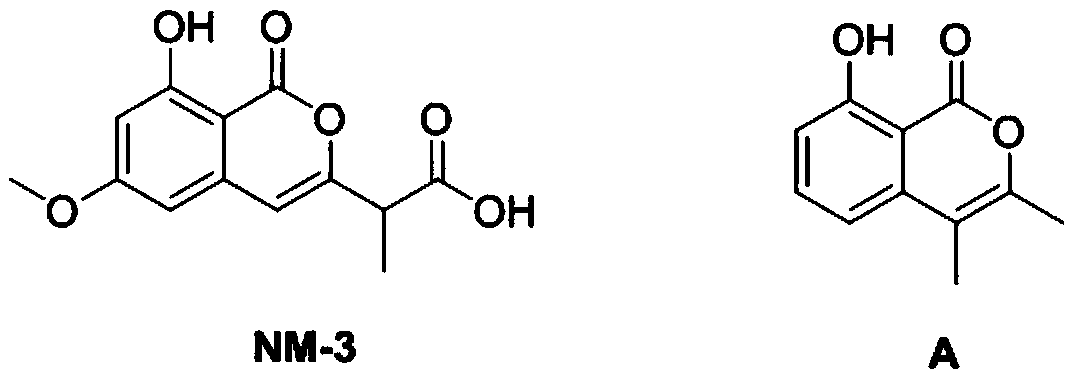Synthetic method of isocoumarin ramification
A technique for synthesizing isocoumarin and its synthesis method, which is applied in the field of synthesis of isocoumarin derivatives, can solve the problems of insufficient mild reaction conditions, long reaction time, and low yield, and achieve short reaction time, ideal yield, and low raw material cheap effect
- Summary
- Abstract
- Description
- Claims
- Application Information
AI Technical Summary
Problems solved by technology
Method used
Image
Examples
preparation example Construction
[0023] The synthetic method of isocoumarin derivatives, comprises the steps: raw material 2-((2-R 2 )-ethynyl) methyl benzoate II is dissolved in dimethyl sulfoxide or deuterated dimethyl sulfoxide, dripped into thionyl chloride, and reacted to obtain isocoumarin derivatives I;
[0024]
[0025] In the formula:
[0026] R 1 are hydrogen atoms, methyl groups, fluorine atoms and bromine atoms;
[0027] R 2 hydrogen atom, phenyl, p-methoxyphenyl, p-nitrophenyl, p-chlorophenyl, 2-methoxycarbonylphenyl, 2-nitro-4-methylphenyl, 1-naphthyl, 2-thienyl, tert-butyl or trimethylsilyl;
[0028] R 3 is methyl or deuterated methyl.
[0029] Among them, 2-((2-R 2 The molar ratio of )-ethynyl)methyl benzoate II to thionyl chloride is preferably 3:1.
[0030] 2-((2-R 2 )-ethynyl)methyl benzoate II in dimethyl sulfoxide or deuterated dimethyl sulfoxide optimal reaction concentration of 1mmol / mL.
[0031] The reaction temperature was room temperature (25°C).
Embodiment 1
[0034] Preparation of 3-phenyl-4-methylthioisocoumarin l-a
[0035]
[0036] 2-((2-phenyl)-ethynyl)methyl benzoate ll-a (0.5mmol, 118mg) was dissolved in dimethylsulfoxide (0.5mL), and thionyl chloride (1.5mmol, 179mg), react at room temperature (25°C) until TLC shows that the substrate is completely reacted. Extract the reaction solution with water (20mL) and ethyl acetate (20mL×3), combine the organic phases, wash the organic phase with saturated brine, add anhydrous sodium sulfate to dry, add the organic phase to a column of silica gel and evaporate to dryness, column chromatography (acetic acid Ethyl ester:petroleum ether=5:95) to obtain 127 mg of white solid with a yield of 95% and a melting point of 127-128°C. 1 H NMR (600MHz, CDCl 3 )δ8.36(dd, J=7.8,1.2Hz,1H),8.24(d,J=7.8Hz,1H),7.88-7.85(m,1H),7.80-7.78(m,2H),7.59-7.56 (m,1H),7.48-7.46(m,3H),2.16(s,3H). 13 C NMR (150MHz, CDCl 3 )δ161.6, 158.0, 138.1, 135.3, 133.2, 130.0, 129.9, 129.8, 128.6, 127.9, 125.6, 120.9,...
Embodiment 2
[0038] Preparation of 3-(2-thienyl)-4-methylthioisocoumarin l-b
[0039]
[0040] Dissolve 2-(2-(2-thienyl)-ethynyl)methyl benzoate ll-b (0.5mmol, 121mg) in dimethyl sulfoxide (0.5mL), drop into thionyl chloride (1.5 mmol, 179mg), react at room temperature (25°C) until TLC shows that the substrate is completely reacted. Extract the reaction solution with water (20mL) and ethyl acetate (20mL×3), combine the organic phases, wash the organic phase with saturated brine, add anhydrous sodium sulfate to dry, add the organic phase to a column of silica gel and evaporate to dryness, column chromatography (acetic acid Ethyl ester:petroleum ether=5:95) to obtain 123 mg of a yellow-green solid with a yield of 90% and a melting point of 139-140°C. 1 H NMR (600MHz, CDCl 3 )δ8.32(dd, J=7.8,1.2Hz,1H),8.22(d,J=7.8Hz,1H),8.07(dd,J=3.6,1.2Hz,1H),7.85-7.82(m,1H ),7.55-7.51(m,2H),7.16(dd,J=5.4,4.8Hz,1H),2.32(s,3H). 13 C NMR (150MHz, CDCl 3 )δ160.8, 152.5, 138.6, 135.3, 134.0, 131.4, 131.3...
PUM
 Login to View More
Login to View More Abstract
Description
Claims
Application Information
 Login to View More
Login to View More - R&D
- Intellectual Property
- Life Sciences
- Materials
- Tech Scout
- Unparalleled Data Quality
- Higher Quality Content
- 60% Fewer Hallucinations
Browse by: Latest US Patents, China's latest patents, Technical Efficacy Thesaurus, Application Domain, Technology Topic, Popular Technical Reports.
© 2025 PatSnap. All rights reserved.Legal|Privacy policy|Modern Slavery Act Transparency Statement|Sitemap|About US| Contact US: help@patsnap.com



